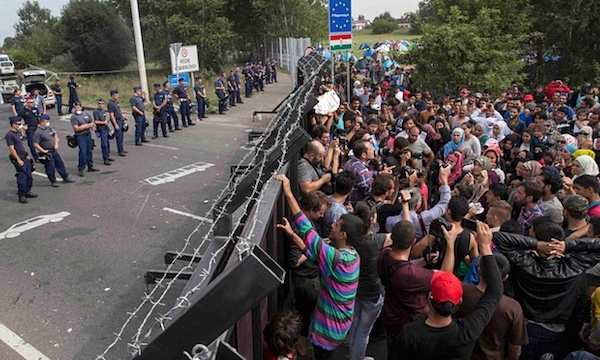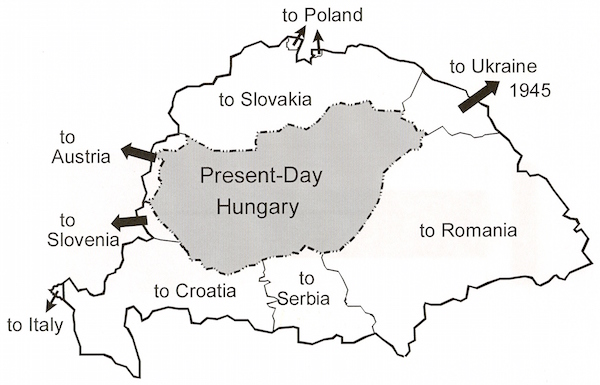Hungary: On the Border, Disorder
“Fifty meters past the border barrier, the Hungarian border station looms, with Hungarian and EU flags fluttering, the station’s condition considerably better than the Serbian. I long ago gave up trying to use my limited Hungarian, as it made them suspicious, and I usually used my US rather than my Greek passport, even though Greece is a fellow EU member. A few quick questions, and I am in Hungary. If you slept through the process, as my then toddler daughter often did, you would not know you were in another country.”—Alexander Billinis
Roaming East Roman
By Alexander Billinis

 CHICAGO Illinois—(Weekly Hubris)—9/28/2015—From my doorstep in Sombor, it is 30 kilometers away, out of the city, through the gently undulating fields of Vojvodina, passing a couple of villages, to Backi Breg, the final village. Not 100 meters from the final house, in that final village, the border beckons. The Serbian border guards, relaxed and friendly, check my passports. I am a regular, and they know me: foreign registered vehicle, Greek and US passports, Serbian residence permit. Most often, my traveling companion is a toddler, my daughter.
CHICAGO Illinois—(Weekly Hubris)—9/28/2015—From my doorstep in Sombor, it is 30 kilometers away, out of the city, through the gently undulating fields of Vojvodina, passing a couple of villages, to Backi Breg, the final village. Not 100 meters from the final house, in that final village, the border beckons. The Serbian border guards, relaxed and friendly, check my passports. I am a regular, and they know me: foreign registered vehicle, Greek and US passports, Serbian residence permit. Most often, my traveling companion is a toddler, my daughter.
Fifty meters past the border barrier, the Hungarian border station looms, with Hungarian and EU flags fluttering, the station’s condition considerably better than the Serbian. I long ago gave up trying to use my limited Hungarian, as it made them suspicious, and I usually used my US rather than my Greek passport, even though Greece is a fellow EU member. A few quick questions, and I am in Hungary.

If you slept through the process, as my then toddler daughter often did, you would not know you were in another country. Sure, the language was different, but Serbia’s Vojvodina province has plenty of Hungarians, and the villages we passed through, from Sombor to the border, were full of ethnic Hungarians. Further, the first Hungarian village, Hercegszanto, announced itself in Hungarian, Latin-alphabet-Croatian, and Cyrillic-Serbian. There was a Serbian Orthodox Church in town, and a Catholic Church, just as in the mixed villages less than a kilometer away, in Serbia. The people too, a mixture of Hungarian, various south Slavs, and a few assimilated Germans from Maria Theresa’s time, looked the same as directly south of the border. Ditto the Austro-Hungarian village architecture, together with Socialist realism houses dating from a more recent, prosaic era.
Four or more times a month, we would take this cross-border trip, sometimes just for shopping, because the prices and Value Added Taxes were lower than in Serbia; other times for travel and writing, while I chronicled the monuments of Hungary’s vanishing Serbian community. If my wife and son were in tow, it might be a trip to a thermal bath, the historic cities of Mohacs or Pecs, or a once-a- year trip to Budapest, a city where I spent an unforgettable university semester, just as another border, the Iron Curtain, was coming down.
Though traversing the border at this crossing, off the main highways between two small villages, was a quick affair, particularly when armed with EU or US passports, I always felt a lump in my throat when I was in the process of passing from one jurisdiction to the other, and through that no-man’s land in between. In the US, the Fourth Amendment, protection against searches and seizures, does not apply at the nation’s borders, and I always feared a mistake, a misplaced or expired document, or some randomly forgotten item, that could get me in trouble. For me, the watch-phrase was: “They can always find a problem or mistake” (in your documents or papers).
This was not a happy border, though few are, in my experience.
It was basically a cease-fire line, never really accepted by the Hungarians, who lost their Hapsburg-era “Great Hungary” after World War One. All over Hungary, cars sport small map decals of Greater Hungary, with borders going well south of the border we had just crossed, all the way to Belgrade. Though the villages on both sides are similar in nearly every way, the border remains an indictment.
With the expansion of the European Union to Hungary in 2004, the border took even a newer dimension of meaning. On one side, the European Union, with the promise of prosperity, regional and agricultural aid, no borders; and, on the other side, the chaotic Balkans, virtually non-Europe, a state to which the Central European Hungarians (notwithstanding their own long lost Asiatic linguistic origins) relegated the “Byzantine Orthodox” Serbs.
Every time a Hungarian scoffed at my Serbian residence permit, I remembered a professor of mine in Budapest, now a key advisor to Prime Minister Orban, who openly told naïve Americans that Hungarian civilization was superior to Serbian. (Hungary, in the EU, and Serbia out, was to the Hungarians a confirmation that they were in the club, and the Serbians were definitively not.)
In 2004, when the Schengen Area visa free travel policy went into effect, this border station became the front line of a vast borderless zone. After the five-minute border shuffle, we needed only show passports again were we to cross the English Channel. We could literally drive to the Norwegian Arctic and never be required to present a passport.
The Hungarians, officious enough already, suddenly saw themselves as the keepers of Europe.
It is no surprise, therefore, that this border has become a front in the vast, emerging, migrant wave from the Middle East. Whereas Hungarians braved death in 1956 to cross their own barbed wire and, in 1989, their destruction of the iron fence between Hungary and Austria was the catalyst that brought down the Berlin Wall in 1989, these same Hungarians, children of the 1989 Revolution, are now building a piano-wire curtain across their border to keep refugees out.
This border, the one I knew better than any other, will never be the same.
To say I am disappointed would be an understatement, but to say I am surprised would be disingenuous. I always feared that the borders closed before Schengen would somehow close once more; that the dust and rust of the old border stations could easily be wiped away and all-too-eager bureaucrats return to their respective places, consigning open borders—and minds—to recent history.
Perhaps this is why I and my family left Europe after nearly a decade, “one hour ahead of time,” as the Greeks would phrase it, to avoid witnessing what is occurring now in Hungary.
Instead, however, we see it all too clearly on our multiple screens.
Somehow, though, our pain is muted: a simple mouse-click puts it out of sight, if not mind.
![]()
Note: The first image in the essay above, a photograph taken by Marko Djurica, of Reuters, derives from The Guardian.
![]()
To buy Alexander Billinis’ latest book, The Eagle Has Two Faces: Journeys Through Byzantine Europe, click on the cover below:


4 Comments
Will
Thank you, Alexander Billinis. This perspective is not available through reading the “news”. It should be.
Jean Nolan
Oh, this is wonderful, and a far better history lesson than any I received in (a fairly good) school. Thank you. This is lucid and lyrical, at once.
Anita Sullivan
I enjoyed your essay very much, Alexander. My mother was an immigrant from Hungary to New York with her sister and parents in 1921. I hunger (no pun intended) for direct information from that country always, which normally is not “in the news” much, but right now it pains me to see the Hungarians acting like adolescent thugs. I look forward to more of your writings!
Alex Billinis
Thank you for the comments. Anecdotes and unofficial histories are always, in my opinion, better history than the official version. As for Hungarians, I love them, they have their better angels as well as their demons. Every nation has a good and bad angel, each on one shoulder.